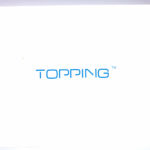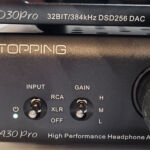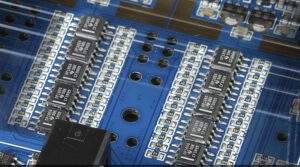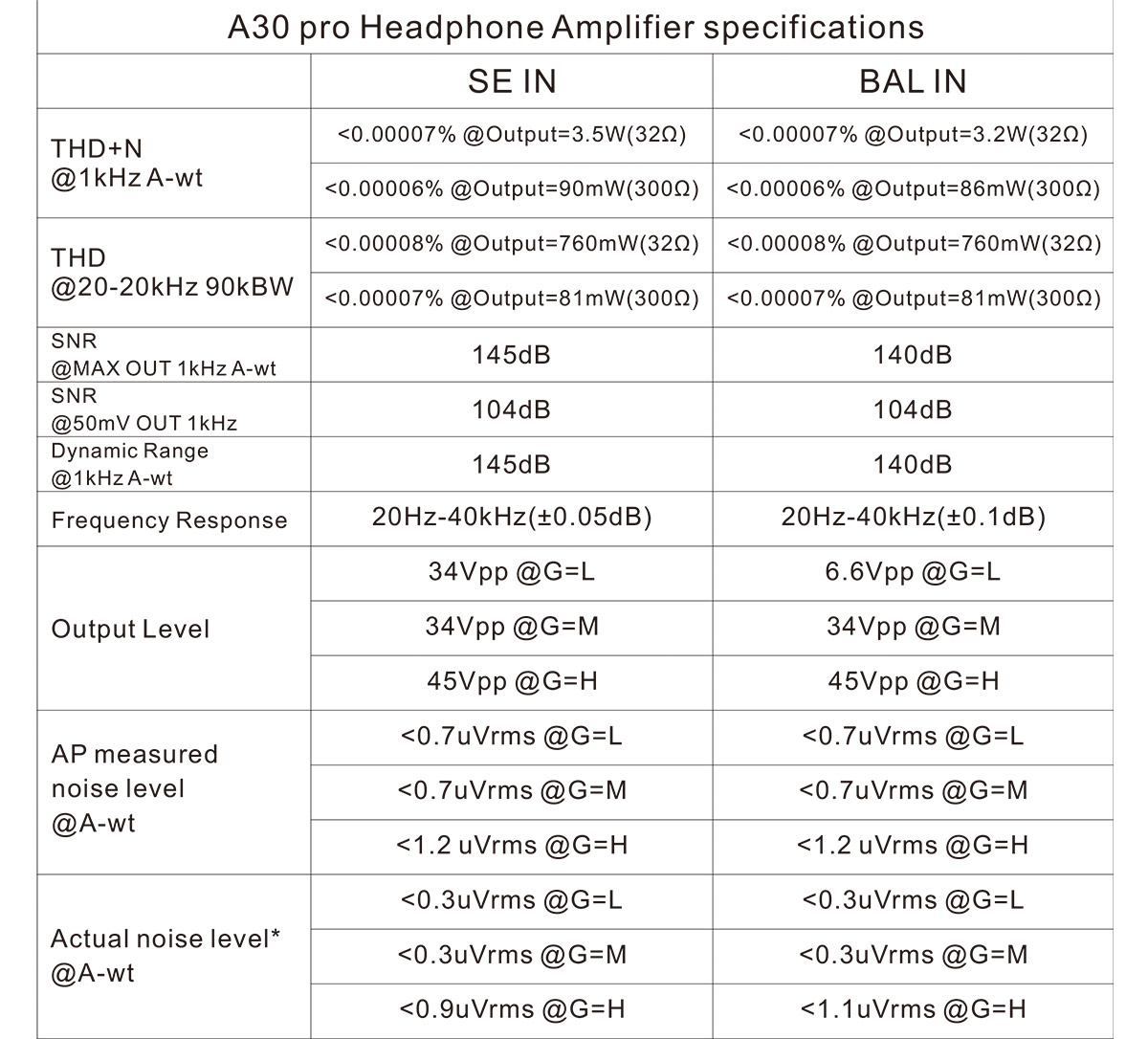Disclaimer: The Topping A30pro was provided for purpose of this review by Apos Audio. Apos sells the A30pro in combination with the D30Pro DAC and XLR interconnect cables as an Apos Ensemble. The Ensemble contains everything needed to start using the D30Pro/A30Pro immediately and retails for $779.99. I have no affiliation with Topping or Apos Audio, nor have I received any compensation beyond the unit itself for this review. If you have an interest in Topping, check out their website or to purchase your own Topping 30Pro Ensemble check out Apos Audio
Unboxing:
The A30 comes in a small lift-top box with the topping name on top and the model name on the side along with Topping’s address. If you weren’t already familiar with what you were getting, the box would do little to encourage a purchase and is very obviously more about transport than marketing the product. Inside the box a small closed cell foam surround protects the unit and keeps it separate from the power cord, manuals, and 6.35 to 3.5mm adapter. The kit does not include any interconnect cables so you’ll need at least one pair to complete the hookup process which Apos provides if purchasing the Ensemble.

 Build:
Build:
The A30Pro shares the casing with the D30Pro DAC and is the mid-sized model between the D90 that is a full stereo component size and the L30 which is 1/4 size. The A30Pro is designed as a desktop companion for tighter spaces than the D90/A90 can fit. The case is brushed aluminum available in natural color or black anodized. From left to right, the face of the A30pro has a power LED indicator, a 3 position input switch, a 3 position gain switch, an XLR output, 4.4mm pentaconn jack, 6.35mm jack, and finally the volume control knob at far right. The reverse is equally busy with XLR inputs, RCA inputs, RCA outputs, a pair of 6.35mm mono outputs for balanced pass through, with a ground/lift switch above them (more on this in a minute), and finally the power input and switch.



 Internals:
Internals:
This is where it gets complicated. With balanced inputs and an XLR and 4.4mm output, we’d expect the A30Pro to be fully balanced and differential. Put simply, it isn’t what most expect it to be. Technically speaking it does use separate grounds for the 4.4mm and XLR connectors so it meets the technical definition of balanced requiring equal paths to ground, but it is not differential with measurements confirming that the two pins for left channel in the XLR and V+ and ground rather than V+/V- as is typically seen. Technically speaking V+/V- defines a differential amplifier and not a balanced one, but the two are often used interchangeably. Output power is the same regardless of which output is used so there is no gain in potency to be had by using the 4.4 or XLR over the 6.35mm. Thankfully, the A30pro has plenty of power using the 6.35mm so having an assortment of connector types does increase the versatility of the amp as it can power anything from easy to drive dynamics through the big planars. I measured a nearly 3 watts of output power with a 32Ω load and 450mW with a 600Ω load. The heart of the A30Pro is an array of OPA1656 op-amps in a nested feedback composite amplifier circuit. Topping introduced the circuit with the A90 and it has both trickled down into other products and been improved along the way. The design is a hybrid current drive amplifier so it works equally well with headphones with a high current demand and those with a larger voltage demand. Nominal output impedance is less than 0.1Ω. Noise levels are so low that another amplifier has to be placed between the A30pro and the measurement device and then results divided by the amplification factor of the secondary amp. Tested without a secondary amp, even the vaunted Apx555b analyzer is not sensitive enough to measure the noise level. That’s simply amazing for a $349 amp.

Sound:
I did my listening with a combination of the D30pro that was shipped as part of the Apos Ensemble and with my RME ADI-2 as DAC. Some will find the pairing of the ADI-2 as overkill since it retails for more than 4 times the cost of the A30Pro but I wasnted to really wring out everything the A30pro was capable of so using a DAC that provide crazy detail levels makes sure the Amp isn’t restricting it. One thing is evident regardless of the DAC paired to the A30Pro. It has some power and authority. Bass hits are potent but control is very good as well so the punch is exactly where it should be and doesn’t spread out. Likewise, repeated strikes don’t lose impact as they can with some lesser designs. The A30Pro delivers solid mids as well with good note weight and clarity throughout the range. Treble is well extended as well with no notable roll-off being attributable to the amplifier.
I think the big take away for me was how well the A30pro handled just about everything. No matter what track I played or what headphone I had connected, the A3opro delivered the goods. Big hits were big, quiet passages were quiet, fast complex sequences were delivered effortlessly with no loss of clarity or impact. This is a potent amp and its power handling is definitely its best trait. It won’t make things buttery smooth or tube like, but it can slam with the best of them when called upon.
Comparisons:
It seems only fair to look above and below the A30Pro in the Topping line to see what saving a bit costs feature wise or what spending a bit more gains.
The A50s is the next step below the A30Pro at $249 while the A90 at $499 is the step above it in the line.
The A50s despite the name sounding like it should be a step up is a step behind the A30Pro in both power and clarity even accounting for the balanced/differential output of the A50s. The A50s is at its best when used with balanced inputs and balanced headphones but even in that configuration it lacks some transparency and more than a little power when placed side by side with the A30pro. Both share similar construction and size while not exactly alike is close enough that if one won’t fit the space, the other likely won’t either. The A50s also uses a DC wall wart rather than having an internal power conversion so many pair a linear power supply with it that brings the cost above the A30Pro.
The A90 is the flagship and it shows as it has a more robust feature set than the A30Pro. The A90 has a true pre-amp functionality rather than the simple pass through of the A30pro and also has true differential amplification so is capable of delivering even more potency than the A30Pro. In most respects the A30pro is very much the little brother of the A90 with similar construction and circuit design. The A30p just uses 50% of the A90 as a single ended model while the A90 doubles the circuit count by offering true differential output.
Other common headphone amplifiers at roughly the same price are products like the SMSL SH-9 and Schiit Jotunheim. Both of these offer strong competition for different reasons. The SH-9 is very similar to the A30pro in size, build quality, power, and output. Both are single ended that have balanced output connectors for convenience sake rather than differential outputs. The SH-9 uses the THX 888 module and has similar measurements. Its noise level isn’t quite as good as the A30Pro boasts but still well below the level of audibility. I think the SH-9 sounds a little dryer and has a bit more top end emphasis but with it being slightly less expensive than the A30pro it certainly bears consideration.
The Jotunheim on the other hand is the same price as the A30pro in its most basic configuration and can quickly escalate to double the price if a DAC module or phono pre-amp is included. The upside for the Jotunheim is space conservation and flexibility with balanced power output that exceeds what the A30pro can deliver. In singled ended mode, the Jotunheim is slightly less potent than the A30pro. Some will argue that with only the ESS 9028 and AD5547 DAC modules available that the Jot is somewhat limited but one can always plug in an external dac so this really isn’t a disadvantage. This one comes down to preference as the A30pro measures better than the Jot, but both sound really good to my ear.
Thoughts/Conclusions:
With trickle down tech from the A90, I had expected great things from the A30pro. I will admit finding out it was a single ended amp with balanced connections for convenience sake rather than being a fully differential amp I was a bit disappointed as I had hoped for a true budget A90. On the flip side, the single ended output of the A3opro more than rivals a lot of its competitors balanced output both in power and in quality. One upside to the A30Pro is that you can use whatever jack you like and get the same sound quality out of it. Too often an amp is great balanced but only passable in single ended and although not nearly as common I have seen instances where an amp was better in single ended mode than in balanced. With the A30pro you get the same signature across the range of connections so no worries about buying new cables for all your headphones to match the new amp you bought. Sound wise the A30pro delivers a clean, neutral, well detailed sound with plenty of potency if coming off slightly clinical. Its quite a departure from my tube amps that offer a lot of warmth and coloration and much closer to the ADI-2 or Pass HPA-1 in presentation. That puts it in pretty good company for an amp that costs less than replacement remote for the ADI-2 or a servicing for the HPA-1.

















